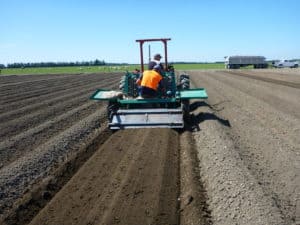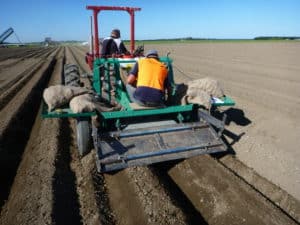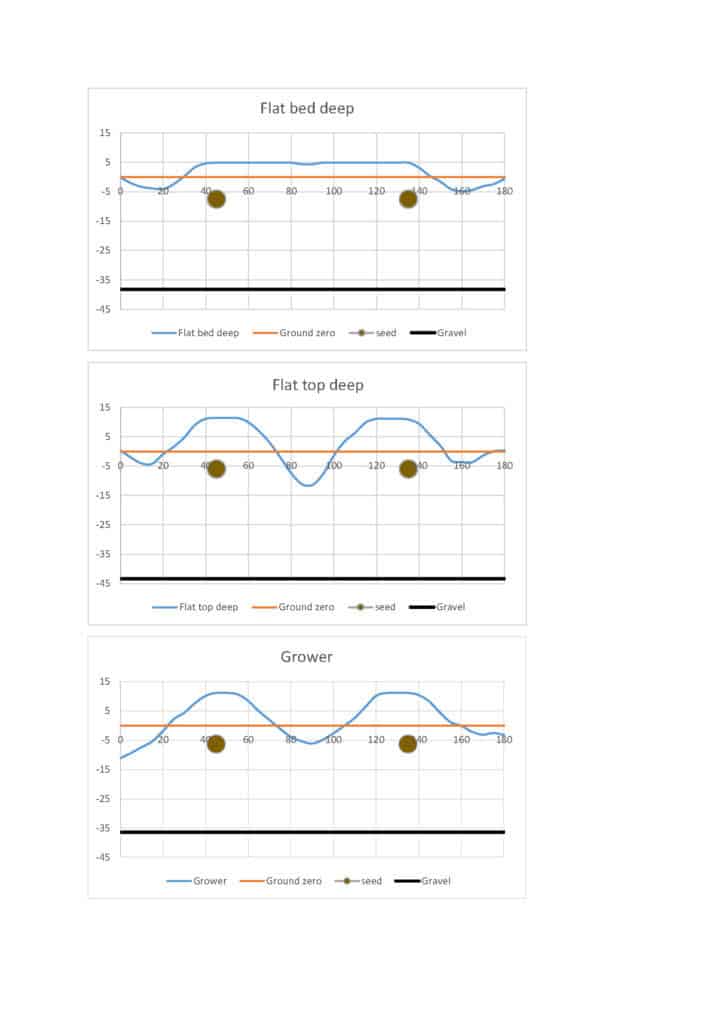Alex Michel, Sarah Sinton and Steven Dellow, Plant & Food Research (PFR)
Potato crops require high water supply and are often competing with other crops on the farm for irrigation through the summer months, when demand is high and supply can be limited.
In the 2015-16 season, an experiment was run on a PFR experimental block with a deep (2 m to gravel) Templeton silt loam soil (190 mm/m of depth available water holding capacity). Treatments consisted of 2 bed shapes (ridge/furrow and flat-bed) and 2 irrigation regimes (full irrigation, which was irrigated twice weekly to replace soil water deficit, and low irrigation, which was irrigated when soil water deficit in the top 400 mm of soil was close to wilting point).
Plots were 12 rows by 10 m long. Whole seed ‘Bondi’ was used and planted 200 mm deep. Seed and row spacing were, respectively, 280 mm and 0.8 m for both bed shape treatments. Irrigation was applied using a single span lateral irrigator.
There were some indications of a yield increase (7 t/ha) in the flat-bed plots compared to the ridge/furrow plots under full irrigation. This was supported by measurements of soil water storage and drainage properties under the different bed shapes, which showed that flat-bed plots had higher storage of available water for crop growth and that drainage was faster in the ridge/furrow plots. WUE was not much affected by bed shape.
In the current season (2017-18), a bed shape experiment is being conducted in a commercial ‘Russet Burbank’ crop located on a shallow (30-40 cm to gravel), well- drained Lismore silt loam soil.
The treatments are:
- 2 bed shapes:
- Flat-top ridge/furrow
- Flat-bed
- 2 seed depths:
- Shallow: 15 cm for flat-top ridge/furrow, 10cm for flat-bed
- Deep: 20 cm for flat-top ridge/furrow, 13 cm for flat-bed
- A grower comparison (part of the commercial crop): ridge/furrow shape and 20 cm seed depth
The trial was planted using a modified two row planter (Figure 1) and the same seed material as for the rest of the crop. Crop management for the trial is the same as the rest of the crop and carried out by the grower. Plots are 6 rows (3 beds) by 20 m.
 |
 |
| Figure1.Formation of two row flat-bed | Formation of flat-top bed (using a modified Grimme planter) |
Soil water content is recorded every 15 minutes down to 35-40 cm using automated sensors (TDR) installed in the beds. Rainfall and irrigation are recorded using plastic rain gauges.

Figure 2 shows the bed shape and soil profile information for the different treatments: bed architecture relative to ground zero, seed position and depth to gravel.
Figure 2. Graphically represented cross sections of three bed-shape treatments: flat-bed ‘deep’ planted seed, flat-top ‘deep’ planted seed, grower bed shape (measurements are cm). The blue line represents the average measured bed shape, the red line represents ground zero, the brown circles represent seed placement, and the black line represents the start of a gravel layer.
At crop maturity, the crop performance under the different treatments will be assessed by measuring yield, tuber size class distribution, tuber disease and defects level, and any other relevant crop parameters.


